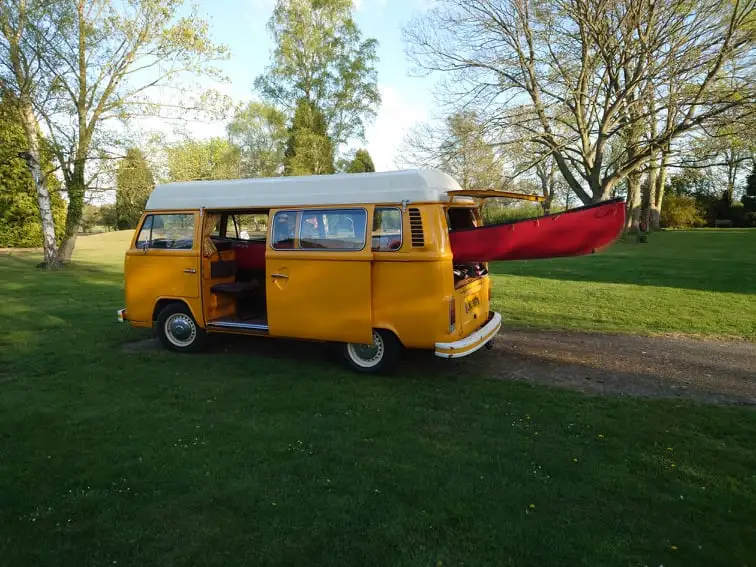Volkswagen Camper Van Tyres
VW Camper Van 1949–2003

- The VW Camper van fitted either 7.00-14 crossply tyres or radial 185 R 14 Tyres.
- Because the old VW Kombi camper van is a commercial vehicle it needs a higher load rating than a standard car.
- We suggest fitting these 185 R 14 8PR Galaxy Whitewall tyres.
- Our period fitment guides suggest that Camper Van models switched from tube-type wheels to tubeless wheels between 1979 and 1982. If you have a camper with OE wheels that are tubeless pre-1979 or tube-type post-1979 please get in touch so that we can be more accurate for future enthusiasts!
- The correct tube for 185 R 14 tyres is the Michelin 14F innertube.
- Suggested VW Camper van tyre pressure 28psi front and 36psi rear.
History of the Volkswagen Camper Van
The Volkswagen Type 2 was a panel van debuted in 1950 by German automaker Volkswagen as its second automobile model, following and initially stemming from Volkswagen's first model, the Type 1 (Beetle). It was given the factory name Type 2. The van, like the Beetle, has several nicknames across the world, including "microbus" "minibus" "kombi" and, due to its popularity during the 1960s counterculture movement, "hippie van"
Ben Pon, a Dutch Volkswagen importer, is credited with the Type 2 idea. (It is conceptually comparable to Buckminster Fuller's 1920s Rumpler Tropfenwagen and 1930s Dymaxion automobile, neither of which was produced.) Pon went Wolfsburg in 1946 with the intention of purchasing Type 1s for import into Holland. While there, he spotted an improvised parts-mover and concluded that something better might be built using the original Type 1 pan. He initially drew the van in an April 23, 1947 doodle, suggesting a payload of 690 kg (1,500 lb) and positioning the driver at the very front. However, production would have to wait because the plant was already at capacity building the Type 1.
When capacity became available, a prototype known internally as the Type 29 was built in three months. The prototype employed a ladder chassis with unit body assembly since the original Type 1 pan proved to be too weak. The wheelbase was coincidentally the same as that of the Type 1. Engineers repurposed the Type 81's reduction gear, allowing the 1.5-tonne van to run on a 25 hp flat four engine.
Despite the fact that the early prototypes' aerodynamics were inadequate (with an initial drag coefficient of 0.75), engineers utilised the wind tunnel at the Technical University of Braunschweig to refine the design. Simple improvements like forming the windscreen and roofline into a "vee" allowed the production Type 2 to achieve a drag coefficient of 0.44, which was higher than the Type 1's 0.48. Volkswagen's new CEO, Heinz Nordhoff (installed on January 1, 1948), cleared the van for production on May 19, 1949, and the first production vehicle, now known as the Type 2, came off the assembly line on November 12, 1949.
There were only two types available: the Kombi (with two side windows and centre and rear seats that could be readily removed by one person) and the Commercial. The Microbus was introduced in May 1950, and the Deluxe Microbus followed in June 1951. In all, 9,541 Type 2s were produced in their first year. In December 1951, an ambulance variant was added, which shifted the gasoline tank in front of the transaxle, relocated the spare tyre behind the front seat, and added a "tailgate"-style back door. From 1955 until 1967, these characteristics were standard on the Type 2. The 1951 model year saw the production of 11,805 Type 2s. In August 1952, these were joined by a single-cab pickup, which changed the least of the Type 2s until they were all substantially modified in 1968.
Unlike earlier rear-engined Volkswagens, which changed over time but never saw the launch of all-new models, the Transporter not only evolved but was totally updated on a regular basis, with variants referred to retroactively as versions "T1" through "T5" (a nomenclature only created after the introduction of the front-drive T4 that replaced the T25) However, only versions T1 through T3 (or T25 as it is now known in Ireland and the United Kingdom) may be considered directly connected to the Beetle.
The Type 2 and the 1947 Citroen H Van were two of the earliest 'forward control' vans, with the driver positioned above the front road wheels. They established a trend in Europe, where the design was used by the 1952 GM Bedford CA, 1959 Renault Estafette, 1960 BMC Morris J4, and 1960 Commer FC. In the United States, the Corvair-based Chevrolet Corvan freight van and Greenbrier passenger van mimicked the Type 2's rear-engine configuration, with the Corvair horizontally opposed, air-cooled engine providing power.
Except for the Greenbrier and several Fiat minivans from the 1950s through the 1970s, the Type 2 was the only rear-engined vehicle. This was a drawback for early "barndoor" Panel Vans, which couldn't be readily loaded from the back due to the engine cover invading internal space, but it was typically favourable in terms of traction and interior noise.







